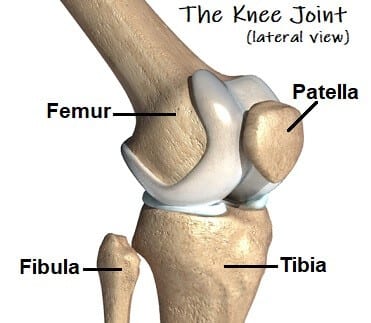Spotlight on The Knee
The knee is the largest joint in the body and, clearly, is one of the most important , allowing us to walk, run, sprint and change direction, all while supporting the body’s weight. It takes a huge amount of pressure throughout our lives and, unfortunately, often starts to fail as we get older. It is also vulnerable to injury during sporting and athletic activities.
Anatomy of the knee: (pic1)
The knee joint is, in essence, 2 bones sitting on top of one another, the thigh bone (femur) and the shin bone (tibia). The kneecap (patella) is found in front of the knee and runs up and down in a groove (trochlea) in the femur.
Cartilage: A protective layer (pic2)
As with any other joint where a bone touches (articulates) with another bone, we have a layer of white, shiny cartilage over the ends of the bones, so they slide smoothly over one another. This is called articular cartilage. Within the knee we also have 2 additional discs of cartilage which add stability and act as shock absorbers in the joint. These are known as the medial (on the inside) meniscus and the lateral (on the outside) meniscus.
Ligaments: Holding it all together (pic 3)
As the knee is 2 bones sitting on top of each other it is inherently unstable. The menisci do help with the stability of the joint but the main strength comes from the ligaments. We have 2 ligaments that cross over each other inside the joint called the anterior and posterior cruciate ligaments. We also have 2 that run up either side of the joint called the medial and lateral collateral ligaments. When force goes through the joint and potentially puts it under strain the ligaments tighten to support it.
Muscles: Pulling power (pic4)
As well as the ligaments, muscles associated with the knee help support the joint and keep us stable. However, the main function of the muscles is to contract, some in one direction, some in another, causing our legs to bend or straighten. These movements in the knee are called flexion (bending or flexing) and extension (straightening or extending). The muscles which extend the knee are the quadriceps and the main muscles which flex the knee are the hamstrings, (which you often hear about when athletes are injured!) It is vital that these muscles are working well for the joint to function properly.
Knee injuries which most commonly cause pain and lack of mobility:
- Torn meniscus – the discs of cartilage are damaged or torn when the femur rotates on the tibia. This can be an acute injury which is extremely painful and can cause the knee to lock or, more often, create a degenerative tear which slowly becomes more and more of a problem. A tear of the medial meniscus is much more common that the lateral and will give you pain on the inside of your knee.
- Medial collateral ligament (MCL) injury – this injury occurs when the knee is forced inwards putting stress on the inside of the knee. We grade ligament injuries from 1 to 3. A grade 1 injury involves just a few fibres of the ligament causing pain and discomfort, whereas grade 3 would be classed as a complete rupture, an injury at least as serious as a broken bone.
- Anterior cruciate ligament (ACL) injury – as with the MCL, there is usually one-off incident injuring the ACL, which doesn’t always have to be in a tackle or involve contact, but could be a twisting injury, for instance whilst landing from a jump, or falling when skiing when the binding doesn’t release.
- Osteoarthritis – often age related, this involves the articular cartilage over the ends of the bones wearing away. This happens with time and can give different levels of symptoms depending on the severity of the changes.
- Anterior knee pain – pain felt over the front of the knee is very common, especially in teenagers, but we don’t always know the exact source of the pain. Examination of the quadriceps to check they are working and supporting the patella is always where to start diagnosis and treatment. Assessment of a patient’s biomechanics and how their glutes are working to is also very important.
- Patella tendinopathy (commonly called tendonitis) – this is caused by a sustained overload or jarring through the patella tendon at the front of the knee. This condition is commonly seen in sports that involve a lot of jumping.
- Patella dislocation – this will always involve some form of trauma causing the kneecap to pop out of the groove it normally sits in.
If you have knee pain or you knee is having an impact on your daily life and activity, please get in touch.
Paul O’Connell – October 2019
Owner and Physiotherapist
